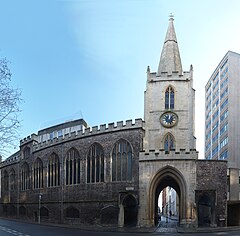Church of St John the Baptist, Bristol
| Church of St John the Baptist | |
|---|---|

St John's church showing the gateway over the city wall
|
|
|
Location within Bristol
|
|
| General information | |
| Town or city | Bristol |
| Country | England |
| Coordinates | 51°27′23″N 2°35′48″W / 51.456313°N 2.596605°W |
Coordinates: 51°27′21″N 2°35′43″W / 51.45583°N 2.59528°W
St John on the Wall in Bristol is a historic church in the care of heritage charity The Churches Conservation Trust. The upper church and its medieval vaulted crypt is located at the lower end of Broad Street and is built into the old city's medieval walls.
The church was built in the 14th century (and heavily modified in the 19th century) with the tower and steeple over St John's Gate, the last remaining city gateway. The church is very narrow as it is built into and alongside the city walls. Consequently, it is also known as St John's on the Wall. The rood stair entrance high up on the wall shows where the earlier great rood screen would have stood. Similar rood stair entrances can be seen at St Peter's, St Philip and Jacob, St Stephen's and Temple. Beneath the church is a vaulted crypt, which was dedicated to the Holy Cross. A conduit has supplied water from Brandon Hill since 1374, and the course of the pipe is marked in places by small plaques set into the pavements.
Among the monuments in the church are those of Walter Frampton (died 1357), thrice Mayor of Bristol and a great benefactor of the church, and a brass commemorating Thomas Rowley (died c. 1478), whose name was used by the 18th century poet Thomas Chatterton as a pseudonym under which to write his forgeries of medieval poetry.
...
Wikipedia

